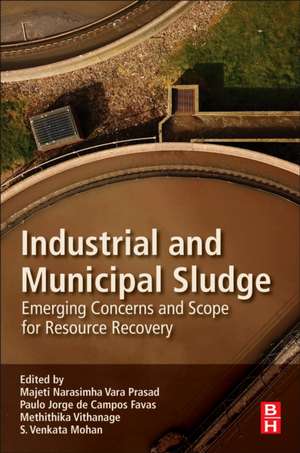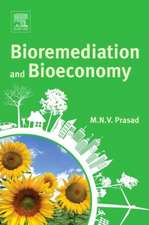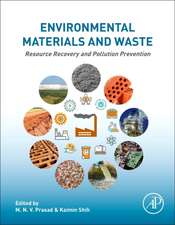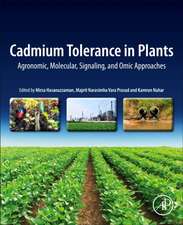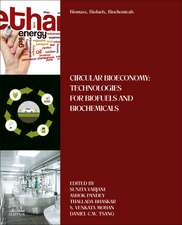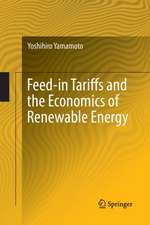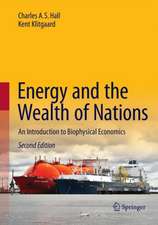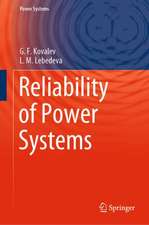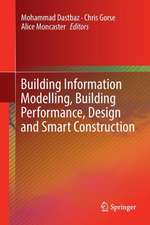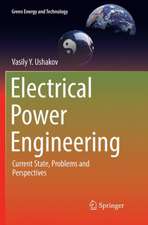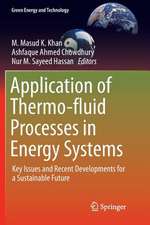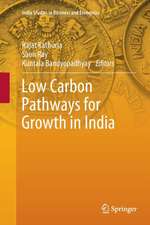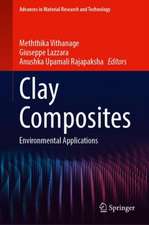Industrial and Municipal Sludge: Emerging Concerns and Scope for Resource Recovery
Editat de Paulo Jorge de Campos Favas, Meththika Vithanage, S.Venkata Mohanen Limba Engleză Paperback – 16 apr 2019
- Includes numerous tables and flow diagrams to assist in the comprehension of new and existing sludge treatments and resource recovery technology
- Covers biogas production by continuous thermal hydrolysis and thermophilic anaerobic digestion of waste activated sludge
- Presents information on the recovery of valuable metals from sludge (bioleaching and the use of a sulfur-oxidizing bacterial community)
- Includes opportunities and challenges in the biorefinery-based valorization of pulp and paper sludge
Preț: 1002.49 lei
Preț vechi: 1270.36 lei
-21% Nou
Puncte Express: 1504
Preț estimativ în valută:
191.89€ • 208.50$ • 161.29£
191.89€ • 208.50$ • 161.29£
Carte tipărită la comandă
Livrare economică 14-28 aprilie
Preluare comenzi: 021 569.72.76
Specificații
ISBN-13: 9780128159071
ISBN-10: 0128159073
Pagini: 856
Dimensiuni: 152 x 229 x 47 mm
Greutate: 1.13 kg
Editura: ELSEVIER SCIENCE
ISBN-10: 0128159073
Pagini: 856
Dimensiuni: 152 x 229 x 47 mm
Greutate: 1.13 kg
Editura: ELSEVIER SCIENCE
Public țintă
Civil/Environmental Engineers and Environmental Scientists, Chemical Engineers, Material Science graduates, , Microbiologists, Biologists and EcologistsCuprins
Section 1: Sludge: Sources and Characterization1. Sludge from waste water treatment plants2. Sludge from pulp, tannery and distillery industries3. Sludge from oil refinery4. Sludge from chemical industry5. Sludge from antibiotic wastewater treatment plants- Fate of antibiotic resistance 6. Earthworms converting milk processing industry sludge into biomanure
Section 2: Sludge Management7. Activation, conditioning and engineering of sludge8. General considerations on sludge disposal 9. Sludge legislation (comparison between different countries)10. Enhanced sludge degradation process using a microbial electrolysis cell11. Sludge dewatering - Processes for enhanced performance12. Rheological characterization of digested sludge
Section 3: Contaminants in Sludge and Treatment strategies13. Ecological and human health risks (general aspects of sludge ecotoxicity and public health)14. Emerging contaminants in sludge (Endocrine disruptors, Pesticides and Pharmaceutical residues, including illicit drugs/controlled substances, etc.)15. Traditional contaminants in sludge (Poly Aromatic Hydrocarbons (PAH) and Poly Chlorinated Biphenyls (PCBs), dioxins, perfluorinated chemicals, alkylphenol surfactants, etc.)16. Bioleaching of sludge [with an enriched sulfur-oxidizing bacterial community]17. Sludge as medium for degradation of textile industry effluents
Section 4: Valorization of Sludge as a Resource18. Fertilizer for agriculture/ Manure for agro-forestry Sludge ash to horticultural crops19. Sludge multifunctions in a phytobiome – (Forest and plantation application incl. microbial aspects)20. Co-composting of sewage sludge and wetland plant material from a constructed wetland treating domestic wastewater21. Biochar production from sludge22. Phosphorus extraction and sludge dissolution23. Recovery of valuable metals from sludge (Bioleaching and use of sulfur-oxidizing bacterial community)24. Water-based paint sludge from automotive industries
Section 5: Energy recovery from sludge25. Co-processing of sewage sludge in cement kiln26. Biorefinery-based valorisation of pulp and paper sludge - opportunities and challenges27. Volatile fatty acid yield from sludge anaerobic fermentation through biotechnological approach28. Biogas (methane production) and energy recovery from different sludges 29. Biogas production by continuous thermal hydrolysis and thermophilic anaerobic digestion of waste activated sludge 30. Sewage Sludge based Microbial fuel cell
Section 2: Sludge Management7. Activation, conditioning and engineering of sludge8. General considerations on sludge disposal 9. Sludge legislation (comparison between different countries)10. Enhanced sludge degradation process using a microbial electrolysis cell11. Sludge dewatering - Processes for enhanced performance12. Rheological characterization of digested sludge
Section 3: Contaminants in Sludge and Treatment strategies13. Ecological and human health risks (general aspects of sludge ecotoxicity and public health)14. Emerging contaminants in sludge (Endocrine disruptors, Pesticides and Pharmaceutical residues, including illicit drugs/controlled substances, etc.)15. Traditional contaminants in sludge (Poly Aromatic Hydrocarbons (PAH) and Poly Chlorinated Biphenyls (PCBs), dioxins, perfluorinated chemicals, alkylphenol surfactants, etc.)16. Bioleaching of sludge [with an enriched sulfur-oxidizing bacterial community]17. Sludge as medium for degradation of textile industry effluents
Section 4: Valorization of Sludge as a Resource18. Fertilizer for agriculture/ Manure for agro-forestry Sludge ash to horticultural crops19. Sludge multifunctions in a phytobiome – (Forest and plantation application incl. microbial aspects)20. Co-composting of sewage sludge and wetland plant material from a constructed wetland treating domestic wastewater21. Biochar production from sludge22. Phosphorus extraction and sludge dissolution23. Recovery of valuable metals from sludge (Bioleaching and use of sulfur-oxidizing bacterial community)24. Water-based paint sludge from automotive industries
Section 5: Energy recovery from sludge25. Co-processing of sewage sludge in cement kiln26. Biorefinery-based valorisation of pulp and paper sludge - opportunities and challenges27. Volatile fatty acid yield from sludge anaerobic fermentation through biotechnological approach28. Biogas (methane production) and energy recovery from different sludges 29. Biogas production by continuous thermal hydrolysis and thermophilic anaerobic digestion of waste activated sludge 30. Sewage Sludge based Microbial fuel cell
